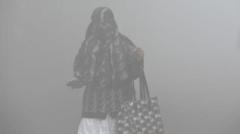The plight of families like Saurabh Bhasin's, who fled Delhi due to severe air pollution affecting their children's health, sheds light on the larger crisis that forces many to choose between well-being and livelihood as India's capital continues to grapple with toxic air.
Families Escape Delhi's Toxic Smog in Search of Clean Air

Families Escape Delhi's Toxic Smog in Search of Clean Air
As air quality in Delhi deteriorates to hazardous levels, affluent families are seeking refuge in cleaner regions like Goa, while many others have no choice but to endure the pollution.
The families fleeing Delhi to escape deadly smog
Saurabh Bhasin, a corporate lawyer, is among those who decided to leave Delhi for the coastal state of Goa after witnessing a drastic decline in his daughter's health. The bustling capital, which was once a vibrant city loved by Bhasin, has devolved into a health hazard due to alarming air pollution levels, especially between October and January. Activities as simple as walking outside or playing at home have become fraught with concerns over harmful air quality.
Back in 2015, driven by the deteriorating air quality and its effects on children, Bhasin petitioned the Supreme Court for a ban on firecrackers, a significant contributor to the winter pollution. His plea, echoed by the concerns of other parents, aimed to alleviate the heavy smog blanketing the city during festive seasons. Although the court issued guidelines regulating their use, pollution continues to plague Delhi year after year.
In November 2022, his daughter was diagnosed with asthma, a triggering factor for Bhasin to seek a new home. The family now resides in Goa, approximately 2,000 km away. For Bhasin, this decision was about ensuring his daughter’s health, acknowledging that while moving doesn’t cure her condition, remaining in Delhi would exacerbate it.
While some families can afford to escape, many residents in Delhi are trapped by economic necessity. Millions continue to endure the toxic air, with a small minority opting for relocation — either temporarily or permanently. "We are no longer willing to pay the price with our child’s health,” Bhasin remarks on their decision.
Local health recommendations underscore the dangers of hazardous air quality, advising vulnerable groups to minimize outdoor activities. However, many find these measures ineffective, as the air consistently falls into the "severe" category. Research reveals that prolonged exposure to pollution can shorten lives significantly.
Rekha Mathur, another resident, has also chosen to leave Delhi during the winter months, moving to Dehradun’s outskirts with her newborn. Her husband’s work prevents him from joining them, forcing them into a difficult arrangement. Though she longs to return, she fears for her child’s future amidst widespread pollution, which now reaches even smaller towns like Dehradun.
Despite ongoing debates regarding Delhi's pollution, remedial actions seem to yield limited results. Year after year, the Supreme Court has mandated various pollution control measures, yet residents witness little improvement in air quality. Journalist Om Thanvi, who lived in Delhi for over 15 years, decided to make a permanent move to Rajasthan, where he no longer requires his inhaler, highlighting the stark contrast in health outcomes.
For individuals like Sarita Devi, the struggle is compounded by economic factors. With a job that requires her to be outdoors, and limited financial options, leaving Delhi is not viable. The air quality crisis is no longer confined to the capital, afflicting many cities across northern India, making escape dreams elusive for many.
For Bhasin, the move to Goa was a difficult yet necessary decision to prioritize his child's health against the backdrop of an ongoing public health crisis in Delhi, confirming that for some, leaving is not merely a lifestyle choice, but a desperate act for survival.




















